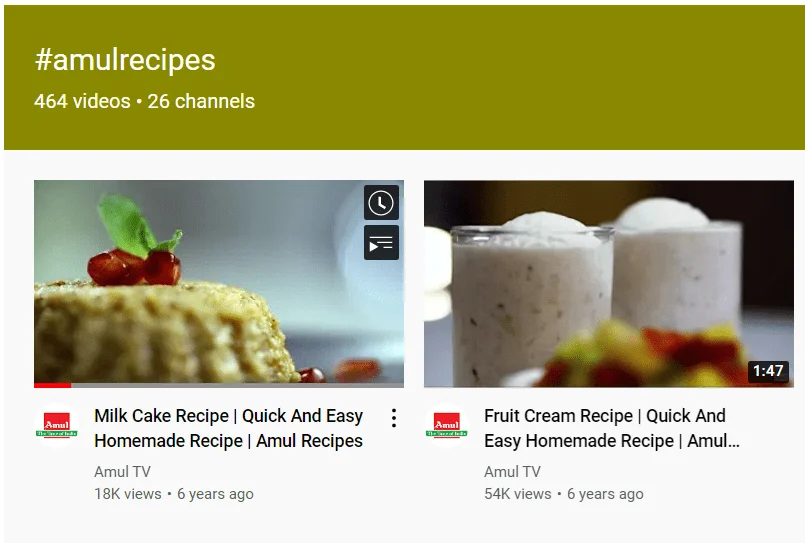It is time to go back in time to one of the most trivial yet significant towns from Gujarat, India, where one of the giants of the food industry was born- Amul. When I say this is not a story you can read, I mean it is not just any tale, these are the stories of revolution pioneered by the people who manned the farms and herded their cattle. When the mechanization process was still at its infancy in the mid 1940s, these farmers were locked out by unfair trade practices. Unfortunately, a myriad of middlemen was squeezing them out and taking most of their profits, just leaving them annoyed and powerless.
But, as they say, where there is a need there will always be a way. Irritated by the exploitation, these determined farmers asked a leading Indian personality, Sardar Vallabhbhai Patel for his guidance. Patel’s guidance was clear and game-changing: “Cut out the middlemen. Choose your life yourself.” And that is what they did that was exactly expected.
Unlike other farmers who complained, in 1946 farmers in Kaira District led by Patel, Morarji Desai and Tribhuvandas Patel flour. They organized a milk strike. Imagine, no milk for days! They did not march; they took a stand. They were ready to fight back and they did start a cooperation which was later known as Amul.
This cooperative was born small with only two village societies and 247 liters of milk. As God would have it, this was just the tip of the iceberg. Tribhuvandas Patel had a visionary leadership for this organization and Dr. Verghese Kurien was the best administrator to turn this small set-up into the giant organization that Amul had become within the dairy industry.
The success was so inspiring that in 1965, India’s then Prime Minister, Lal Bahadur Shastri, took a leaf out of their book to create a national dairy policy, spearheaded by the National Dairy Development Board. The goal was simple yet ambitious: replicate Amul’s model across the country. Dr. Kurien was tasked with leading this mission, setting the stage for a white revolution that would change the face of India’s dairy industry forever.
Market Size and Growth:
The dairy industry in India is growing and the market value which has crossed INR 18,975 billion in 2024 is estimated to reach INR 57,001.8 billion by 2033. That amounts to a compound annual growth rate of 12.35 percent. You know that this high growth rate is a very good sign for any business. That’s possible due to advancements in technology, better online platforms, and proper means of transporting the products — which do not spoil.
Besides, India has been the largest producer of milk globally, contributing nearly 231 million metric tons in the silk route financial year 2022-23 exceeding both the US and China’s milk production rates. With these advancements and quality and variety of products the overall dairy sector in India can observe more growth and advancements can be further made.
Top Competitors:
Amul, a leading dairy brand in India, faces competition from various national and multinational companies. Some of its top competitors include:
Britannia Industries: Founded in 1892, Britannia is a key player in the food manufacturing sector in India, known for its range of dairy products, including milk, cheese, butter, and bakery items. Britannia’s extensive product portfolio and strong market presence make it a significant
Nestle India: A subsidiary of the global giant Nestle S.A., Nestle India offers a diverse array of products including dairy, baby foods, beverages, and chocolates like Kit-Kat and Milkmaid. Nestlé’s global reach and formidable brand reputation position it as a major competitor in the Indian dairy market
Mother Dairy: Founded in 1974 and a subsidiary of the National Dairy Development Board, Mother Dairy is a prominent name in the Indian dairy industry. It manufactures and sells milk and dairy products like paneer, ghee, and ice cream. With a significant market share, especially in the branded milk sector, Mother Dairy is one of Amul’s top competitors.
Cadbury (Mondelez International): While primarily known for its confectionery products, Cadbury competes with Amul in the dairy sector through its popular Dairy Milk chocolates and other dairy-based confections.
Kwality Walls: Owned by Hindustan Unilever, Kwality Walls is a leading brand in the ice cream segment. It directly competes with Amul’s ice cream products through its wide range of flavors and innovative marketing strategies.
4Ps Strategy of Amul

Ever wondered how Amul, the dairy giant, continues to lead and expand in the competitive Indian market? It’s all about their mastery of the classic advertising mix – the 4Ps! Let’s dive into how Amul ingeniously applies Product, Price, Place, and Promotion to stay at the top of the dairy game.
Product:
Currently Amul can be described as a wardrobe of dairy products – one can find something for anybody. Amul not only provides us with butter but also amazing ice cream, cheese, chocolates and everything that we need from our dairy section. What’s their secret? Variety and quality. Regardless of whether it is fresh milk or ghee, they make for a number of different types of quality products to suit a number of different palates amongst consumers. Moreover, with the range of products such as Amul Lite and yogurts of different flavors, it all stays interesting.
Price:
So now let’s move on to the most important question of how it all works for those who are not as lucky. Amul has been very strategic when it comes to the issue of the price while in the market. Their strategy? Keep it accessible.Amul products are thoughtfully priced to ensure that anyone—whether buying a packet of milk or a tub of ice cream—feels valued and deserving of quality. Apart from this, it will also be appealing to the wallet-conscious while at the same time it will guarantee that quality dairy products will be affordable. Again, it is like the cliché, they want to have their cake and eat the butter as well.
Place:
Every day you must have noticed that Amul has its presence everywhere! In large metropolitan supermarkets, country general stores, Amul ensures that its products are obtainable whichever place you are. Second of all, about their smart transition into the digital era – or as many people might like it – now you can order your favorite Amul products via the Internet. This has been translated to thousands of Amul preferred outlets and solid distribution networks that guarantee that one cannot walk several miles without getting an opportunity to grab something Amul if they are hungry.
Promotion:
Amul’s promotion game is uniquely iconic. Remember the Amul Girl? That witty little mascot in her polka-dot dress has been commenting on current events for decades, making us smile while subtly reminding us of the brand’s presence in our lives. Through billboards, TV ads, and now digital platforms, Amul keeps the conversation going. Their creative and humorous ads not only engage but also build a positive brand image that resonates with all ages.
So there you have it, Amul’s 4Ps strategy in a nutshell. It’s how they continue to butter up their customers in the best way possible – by staying relevant, accessible, and engaging. After all, who can resist something that’s “Utterly Butterly Delicious”?
Amulʼs Digital Marketing Strategy
The shift from traditional to digital media was possible for Amul because it already had the experience of creating content. Before it created content for banners and newspapers, which helped the brand avoid radical changes in the approach to creating posts for Facebook and Instagram. Amul uses its emblematic Amul Butter Girl to address current affairs and the events happening around the world; it establishes a relevant and captivating brand image.
A classic case of Amul’s smart use of the social Web is its 2013 campaign “Eat Milk with Every Meal,” initiated with the agency Draftfcb Ulka. Intended for the purpose of refreshing the consumption of milk and derivative products to the consumer, the campaign was to make consumption of dairy products chic and ‘cool’. Using attractive graphics and basic information, Amul was able to associate its dairy products with business and health in the newly emerging field of diet.

Another important activity undertaken was the National Milk Day Campaign on 26-Nov-2019. By creating hashtags such as #CelebratingDrKurien, and #BikeRally, Amul not only honored the figure of Dr. Verghese Kurien, the founder of the White Revolution in India, but also manoeuvred the youth through meaningful storytelling. Apart from the same, few activities conducted for the campaign were; a bike rally from Varanasi to Anand covering 2500 KM altogether and a 70 second film shared on all the social media platforms recounting the turnover and achievements of Dr. Kurien.
Innovating Through Challenges: Amul During COVID-19
The COVID-19 pandemic posed unprecedented challenges, yet Amul’s digital strategy proved resilient. As lockdowns increased household consumption, Amul not only maintained but enhanced its market presence. The brand doubled its digital marketing investments and innovatively used e-commerce platforms like Grofers and Big Basket to meet rising demands. Additionally, Amul developed an app to help customers locate Amul products nearby, emphasizing safety and convenience during the pandemic.
Marketing Campaigns of Amul
Here’s a look at some of Amul’s standout marketing strategies that have captured the imagination of millions across India.
1. #CelebratingDrKurien

In early 2018, Amul continued with the tradition of celebrating its outstanding founder Dr. Verghese Kurien with the help of #CelebratingDrKurien. This mobility saw some cyclists ride from Jammu to Gujarat covering ground that reflects the movement of Dr. Kurien’s dairy mobilization. Along the way, these brand ambassadors of the Amul story related to the farmers for they learned about the change in their lives brought by Dr. Kurien. It did resonate with rural sensibilities and went on to get a lot of image coverage by leading national media dailies and was perhaps the only campaign that got massive media exposure without any direct marketing cost. This innovative way of celebrating was not only the anniversaries but also the great social responsibility that Amul has towards the villages of India.
2. #AmulRecipes

As the digital change swept the market dynamics of brand communication with the consumers, Amul started the #AmulRecipes on YouTube channel. In this venture more than 300 cookery ‘instruction’ videos that seamlessly integrated Amul products into recipes with the effect of giving them the nod of approval for most Indian dishes. Overall, the efforts compiled by the valued readers were surely a grand success in bringing in more than 400k subscribers for Amul’s YouTube Channel. The high number of people who watch these videos is a testimony to the fact that product placement in engaging content is effective in improving the customer’s memory and hence improving on brand recognition.
3. Amul Classics

Whenever there is a desire to relive the good old days, marketers know that people can be sold with this thought and Amul capitalized on this through the Amul Classics. Especially, during the COVID-19 lockdown when many Indian audiences were glued to their television sets while watching all the classics again on Doordarshan such as Ramayan and Mahabharat, Amul saw a great opportunity. Chasing after the requirements of the consumers, it repeatedly streamed its commercials of the 90s both on francophone’s internet sites and on the TV. This helped the company not only to respond to the viewers’ nostalgic feelings but also to strengthen the brand’s association with Indians homes. The campaign was a lovely awakening of the brand and its uninterrupted relationship with the consumers cutting across ages.
So, the next time you enjoy a slice of cheese, a dollop of butter, or a sip of milk, remember the story of Amul—a story of resilience, innovation, and the power of working together. Quite the journey, isn’t it?





